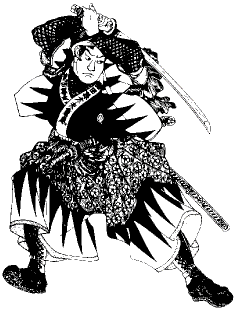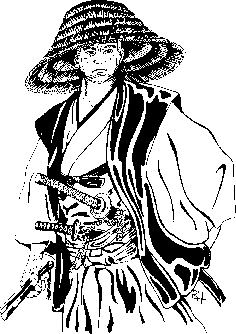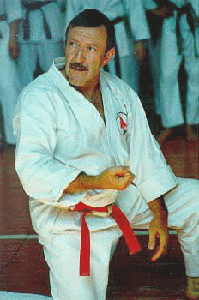" Uniting obstinacy and suppleness constitutes the art of war." Sun Tzu We practice today an impressive number of arts said "martial" (= to make war)
whose list is far from being complete with the arrival of newly discovered techniques all
over the world or newly created by the raging competition in this domain. It is useless to
waste one’s time to discuss hierarchy about all these techniques or about the value
of the countless styles in which they are expressed: it is easy to prove to anybody that
anything can be acceptable at least on a certain number of aspects. When practiced at a
high level, many technical choices may be "efficient", provided this efficiency
can be proved in a society where the warlike dimension is constantly reduced – which
is much to the credit of a civilized society ( it would be more careful to relativize this
concept of efficiency that may be problematic in a really extreme situation, and also the
uselessness to have ever to depend on such an efficiency, even in a civilized society). So
there is no way I shall start this useless debate, that kind of polite conversation
totally unnecessary to any karateka because he/she is above all interested in... practice.
So go on practicing whatever YOU like, and let us try instead to agree on a fundamental
discussion. Among the signs of individual freedom, there is still hopefully the
possibility of the choice one can make between styles, techniques, and underlying mental
attitudes, depending on his/her own physical and mental preferences and dispositions. |
||
|
Let us not resume either the discussion about the difference between martial art and
fighting sports. It is nevertheless fundamental, and my position is well known. For 40
years now, since I first stepped on a tatami ( Judo it was then), I have asserted that
choice often enough and I have stood by it. Just a reminder, for those who are too young
to have had occasion to read my positions on that subject: fighting sports have almost
NOTHING to do with the martial art. Period. I have absolutely no desire anymore to
convince anybody on that matter. I just wanted to remind you about it at the beginning of
a reflection on a theme that concerns any budoka, sooner or later, so that what comes next
shall not surprise ( or even shock ) anyone. |
 |
|
|
Two types of practice have finally come to throw light on one single
direction for research, whose goal emerges as identical, and they have brought a certain
of answers to questions I have always asked myself but that had taken a particular
importance in time. First, there is the Way of Karatedo, and it is the purpose of my Budo
Research Center ( CRB ) to explore the essence of Tradition and to offer a progression
inside the classical ancient martial art. But there is also, and this is certainly not as
widely known, a progression in the same spirit, with different means, inside my
"Tengu Institute": there we search the development of a global concept of
personal defense, more in accordance to the reality of today’s world, a concept that
integrates a series of technical elements, but also mental attitudes, that can be adapted
to different types of situations. These two concerns, always inside the Dojo, follow the
same direction: to enrich "classical" techniques with all the options and
solutions which one can encounter in modern life, to get closer to an up to date, total
and global "martial" concept compatible with our times. Of course, it must also
be evolutive. It is after all about replacing practice in a context of combat where the
first priority is to survive a realistic confrontation, in a contemporary environment.
Finally, that perspective is close to what had to be the meaning of practice of the
ancient Okinawa-Te: the always possible and brutal encounter, stressful, inevitable, with
any form of violence. The violence from the outside, if I can’t escape it, and mine
too... I must try to manage all that, exactly and very precisely as I decide to ( with
control all the way, from the unexpected confrontation with sudden danger to its
elimination ), according to parameters always changing and very different, technically and
humanly, from the conditions a warrior of the "empty hand" could find more than
a century ago. Nevertheless, there is one central thing in common that is the ground for a
reconstruction of a global approach to close combat management: the absolute necessity to
survive the attack... I became aware of this as I confronted my basic martial art with
other forms of possible response to violence during training and experiences made with and
for other professionals of everyday life, which is not always as serene as in a Dojo. |
||
|
This being said, since I want to clearly define the object of my reflection (and let it be understood that it does NOT alter in any way the technical aspect of my traditional Karatedo), I must make clear that using techniques from Karatedo as references, and exemplifying some of my assertions with sequences taken from the martial art I am most familiar with, must not seem restrictive. One shall adapt the general principles mentioned to his/her specific martial field of application. These principles are simply additional means which can be explored under perspectives that complete the one given by the usual teaching in the Dojo. This is by no means a challenge, but maybe a renovation, and also an opportunity for a few modifications, that may allow the art called "martial" to remain really useful in a fast-changing world. |
 |
|
|
Any activity or process taken out of its original context is artificial, anachronistic, out of date. The question is to know what really efficient answer it can give to the questions of today’s men and women. We must move on, integrate to evolve, not turn our backs out of conformity and fear of questioning what has been acquired. I say all this, honestly, to warn the one who has been patient enough to read that far, that my subject will not be historical nor philosophical this time. On that matter, I have extensively expressed my beliefs, in more than 60 books about martial arts published in 30 years, to convince some and to be criticized by others. What I have written and taught has always been what I believe in. I just feel the need to move on, instead of sticking to a comfortable practice only defined by criteria of the past, using wonderful and unverifiable stories, rumors, intellectual digressions that are limited in the real world, therefore are nothing. |
||
|
The practice of a martial art ( I mean its integration to everyday life,
not as a marginal practice) must lead to an attitude, a preparation, and if necessary a
will for action more adapted to the challenges of our times. It must make us think of a
new raison d’être for martial arts inherited from a long history, other than only
their competitive forms ( there is nothing to fear for their future). I wrote long ago
that tomorrow, traditional Budo will be a universal Shin Budo ( shin = new ) or else it
shall disappear. It is time to think about it and to reconstruct it with the obligation of
a new, enlarged, uncompromising and courageous reflection. Tradition must not become a
dusty museum. Whatever the form of practice linking us to it, that form must be considered
as the heart – a central organ indeed but not exclusive- of a day-to-day behavior
inside and outside the Dojo ( protected space), in today’s environment. |
 |
|
|
Anyone practicing an art of the "empty hand" ( understood in the martial sense, neither competitive sport nor free-time activity) must then give back to his/her research the sharp meaning it had originally. The edge of the hand, for instance, must indeed become again a "hand saber" ( Te-Katana) more in the mind of course, than in the external form. Simply understanding it, intellectually, symbolically, is not enough. One must live with the idea that Karate is a weapon, that the whole body in turn, and the mind that controls the body, are a WEAPON. That no weapon is dangerous in itself, but that the reason for being of any weapon is that it is destined to be used one day, except for collections. And if that day was to come, the first thing one can expect from it is to allow one to get out as safe as possible from a brutal and violent encounter. Nothing less. Is it necessary to specify that the spirit of the Tradition itself ( therefore mine ) makes the use of this weapon possible only defensively ? This is precisely a limitation and explains why a confrontation between two authentic Budo masters, who by definition, have got rid of any aggressive impulse, cannot take place... This also explains why a sports competition has nothing to do, strictly speaking, with the expression of a martial state of mind, which I credit with the noble sense enclosed in martial "art" as opposed to fighting "technique": the total confrontation, only when there seems to be no other possible answer, when any other sort of control is impossible, which then takes on graveness and responsibility because of what is at stake. Hence training with a weapon, keeping in mind that it can be used, but always under the guarantee of an ethics. That is also the reason why one should never underestimate the abilities, in an extreme situation, of a person practicing a martial art who never wanted to prove anything just for fun, in a fight with a referee... Is it clear ? Don’t delude yourself : to practice your martial art, as techniques inside the Dojo, as behaviors in everyday life, with a sharp and oriented reflection, is not conceivable if, at the basis of your philosophy of life, your morals or your religion condemns beforehand any will of defensive action, and if you’d better run away, not do anything and possibly be destroyed, to remain faithful to principles. Is it still clear ? Not to criticize your choice. It is your choice. But you must understand that such an attitude is not compatible with what is called in martial arts "the state of mind needed for victory", in the sense of survival, never to develop one’s ego. I am among those who think that it is not only a right ( privilege of the free man ) but a duty ( citizen’s responsibility) to hold out against an opposing violence, with of course a sense of proportion that must be further examined, for which the Legislator makes provision as "self-defense" and assistance to endangered person. I think that pretending to polish a weapon ( Karate) just to make it shine ( to make oneself shine ?) while refusing in advance any possibility to use it ( always that "extreme situation", that can happen once in a lifetime, or never, which should not be hoped for anyway) makes no sense at all. I think that peaceful coexistence for all, so desirable, cannot last without vigilance and that within certain living spaces more protected than others, because the risk is rare indeed, consciousness goes to sleep easily. That is dangerous. Anyone practicing an art of the "empty hand" must link his/her technical learning to the discovery ( or rediscovery ) of authentic martial concepts it involves by its original vocation (that is the "spirit of the technique") for a global and credible approach of his/her close combat techniques. He/she must define and master the rules for the use of these techniques so that he/she is able, when the time comes, to act with the "right spirit". He/she must be careful of the words’ traps and some intoxicating sensations. Thus his/her process in and out of the Dojo will be coherent, throughout his/her life. That is, I think, the first meaning of the "Way" ( Do, Michi, Tao...). To be continued... |
||